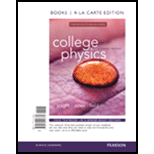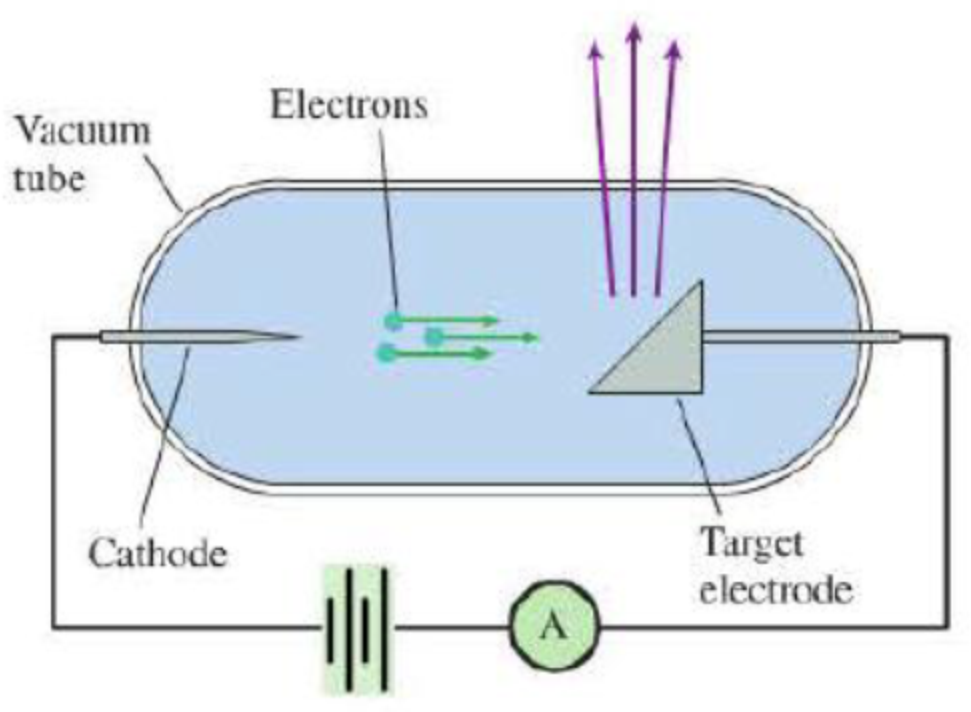
Concept explainers
The following passages and associated questions are based on the material of Part VI
Taking an X Ray
Cathode Turret electrode
 X rays are a very penetrating form of
X rays are a very penetrating form of
FIGURE VI.1

A schematic view of an x-ray tube and a driver circuit is given in Figure VI.1. A filament warms the cathode, treeing electrons. These electrons are accelerated by the electric field established by a high-voltage power supply connected between the cathode and a metal target. The electrons accelerate in the direction of the target. The rapid deceleration when they strike the target generates x rays. Each electron will emit one or more x rays as it comes to rest.
An x-ray image is essentially a shadow; x rays darken the film where they pass, but the film stays unexposed, and thus light, where bones or dense tissues block x rays. An x-ray technician adjusts the quality of an image by adjusting the energy and the intensity of the x-ray beam. This is done by adjusting two parameters: the accelerating voltage and the current through the tube. The accelerating voltage determines the energy of the x-ray photons, which can't be greater than the energy of the electrons. The current through the tube determines the number of electrons per second and thus the number of photons emitted. In clinical practice, the exposure is characterized by two values: “kVp” and “mAs.” kVp is the peak voltage in kV. The value mAs is the product of the current (in mA) and the time (in s) to give a reading in mA · s. This is a measure of the total number of electrons that hit the target and thus the number of x rays emitted.
Typical values for a dental x ray are a kVp of 70 (meaning a peak voltage of 70 kV) and mAs of 7.5 (which comes from a current of 10 mA for 0.75 s, for a total of 7.5 mAs). Assume these values in all of the problem that follow.
What, physically, does the product of a current (in mA) and a time (in s) represent?
- A. Energy in mJ
- B. Potential difference in mV
- C. Charge in mC
- D. Resistance in mΩ
Want to see the full answer?
Check out a sample textbook solution
Chapter P Solutions
College Physics: A Strategic Approach Technology Update, Books a la Carte Plus Mastering Physics with Pearson eText -- Access Card Package (3rd Edition)
- A cannon is rigidly attached to a carriage, which can move along horizontal rails, but is connected to a post by a large spring, initially unstretched and with force constant k = 1.31 x 104 N/m, as in the figure below. The cannon fires a 200-kg projectile at a velocity of 136 m/s directed 45.0° above the horizontal. 45.0° (a) If the mass of the cannon and its carriage is 5000 kg, find the recoil speed of the cannon. m/s (b) Determine the maximum extension of the spring. m (c) Find the maximum force the spring exerts on the carriage. (Enter the magnitude of the force.) Narrow_forwardlaunch angle. Passage Problems Alice (A), Bob (B), and Carrie (C) all start from their dorm and head for the library for an evening study session. Alice takes a straight path,arrow_forwardbelow the horizontal, and land 55 m horizontally from the end of the jump. Your job is to specify the slope of the ground so skiers' trajectories make an angle of only 3.0° with the ground on land- ing, ensuring their safety. What slope do you specify? T 9.5° -55 marrow_forward
- Make sure to draw a sketch and a free body diagram. DO NOT give me examples but ONLY the solutionarrow_forwardMake sure to draw a sketch AND draw a Free body diagramarrow_forwardP -3 ft 3 ft. O A B 1.5 ft Do 1.5 ft ✓ For the frame and loading shown, determine the magnitude of the reaction at C (in lb) if P = 55 lb. (Hint: Use the special cases: Two-force body and Three-force body.)arrow_forward
- A convex mirror (f.=-6.20cm) and a concave minor (f2=8.10 cm) distance of 15.5cm are facing each other and are separated by a An object is placed between the mirrors and is 7.8cm from each mirror. Consider the light from the object that reflects first from the convex mirror and then from the concave mirror. What is the distance of the image (dia) produced by the concave mirror? cm.arrow_forwardAn amusement park spherical mirror shows park spherical mirror shows anyone who stands 2.80m in front of it an upright image one and a half times the person's height. What is the focal length of the minor? m.arrow_forwardAn m = 69.0-kg person running at an initial speed of v = 4.50 m/s jumps onto an M = 138-kg cart initially at rest (figure below). The person slides on the cart's top surface and finally comes to rest relative to the cart. The coefficient of kinetic friction between the person and the cart is 0.440. Friction between the cart and ground can be ignored. (Let the positive direction be to the right.) m M (a) Find the final velocity of the person and cart relative to the ground. (Indicate the direction with the sign of your answer.) m/s (b) Find the friction force acting on the person while he is sliding across the top surface of the cart. (Indicate the direction with the sign of your answer.) N (c) How long does the friction force act on the person? S (d) Find the change in momentum of the person. (Indicate the direction with the sign of your answer.) N.S Find the change in momentum of the cart. (Indicate the direction with the sign of your answer.) N.S (e) Determine the displacement of the…arrow_forward
- Small ice cubes, each of mass 5.60 g, slide down a frictionless track in a steady stream, as shown in the figure below. Starting from rest, each cube moves down through a net vertical distance of h = 1.50 m and leaves the bottom end of the track at an angle of 40.0° above the horizontal. At the highest point of its subsequent trajectory, the cube strikes a vertical wall and rebounds with half the speed it had upon impact. If 10 cubes strike the wall per second, what average force is exerted upon the wall? N ---direction--- ▾ ---direction--- to the top to the bottom to the left to the right 1.50 m 40.0°arrow_forwardThe magnitude of the net force exerted in the x direction on a 3.00-kg particle varies in time as shown in the figure below. F(N) 4 3 A 2 t(s) 1 2 3 45 (a) Find the impulse of the force over the 5.00-s time interval. == N⚫s (b) Find the final velocity the particle attains if it is originally at rest. m/s (c) Find its final velocity if its original velocity is -3.50 î m/s. V₁ m/s (d) Find the average force exerted on the particle for the time interval between 0 and 5.00 s. = avg Narrow_forward••63 SSM www In the circuit of Fig. 27-65, 8 = 1.2 kV, C = 6.5 µF, R₁ S R₂ R3 800 C H R₁ = R₂ = R3 = 0.73 MQ. With C completely uncharged, switch S is suddenly closed (at t = 0). At t = 0, what are (a) current i̟ in resistor 1, (b) current 2 in resistor 2, and (c) current i3 in resistor 3? At t = ∞o (that is, after many time constants), what are (d) i₁, (e) i₂, and (f) iz? What is the potential difference V2 across resistor 2 at (g) t = 0 and (h) t = ∞o? (i) Sketch V2 versus t between these two extreme times. Figure 27-65 Problem 63.arrow_forward
 Glencoe Physics: Principles and Problems, Student...PhysicsISBN:9780078807213Author:Paul W. ZitzewitzPublisher:Glencoe/McGraw-Hill
Glencoe Physics: Principles and Problems, Student...PhysicsISBN:9780078807213Author:Paul W. ZitzewitzPublisher:Glencoe/McGraw-Hill College PhysicsPhysicsISBN:9781938168000Author:Paul Peter Urone, Roger HinrichsPublisher:OpenStax College
College PhysicsPhysicsISBN:9781938168000Author:Paul Peter Urone, Roger HinrichsPublisher:OpenStax College Physics for Scientists and Engineers with Modern ...PhysicsISBN:9781337553292Author:Raymond A. Serway, John W. JewettPublisher:Cengage Learning
Physics for Scientists and Engineers with Modern ...PhysicsISBN:9781337553292Author:Raymond A. Serway, John W. JewettPublisher:Cengage Learning University Physics Volume 3PhysicsISBN:9781938168185Author:William Moebs, Jeff SannyPublisher:OpenStax
University Physics Volume 3PhysicsISBN:9781938168185Author:William Moebs, Jeff SannyPublisher:OpenStax AstronomyPhysicsISBN:9781938168284Author:Andrew Fraknoi; David Morrison; Sidney C. WolffPublisher:OpenStax
AstronomyPhysicsISBN:9781938168284Author:Andrew Fraknoi; David Morrison; Sidney C. WolffPublisher:OpenStax





